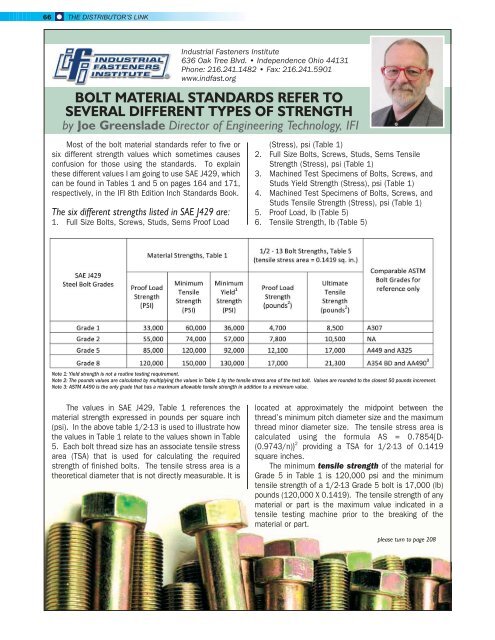SPRING 2012
Distributor's Link Magazine Spring Issue 2012 / VOL 35 / NO.2
Distributor's Link Magazine Spring Issue 2012 / VOL 35 / NO.2
You also want an ePaper? Increase the reach of your titles
YUMPU automatically turns print PDFs into web optimized ePapers that Google loves.
66 THE DISTRIBUTOR’S LINK<br />
BOLT MATERIAL STANDARDS REFER TO<br />
SEVERAL DIFFERENT TYPES OF STRENGTH<br />
by Joe Greenslade Director of Engineering Technology, IFI<br />
Most of the bolt material standards refer to five or<br />
six different strength values which sometimes causes<br />
confusion for those using the standards. To explain<br />
these different values I am going to use SAE J429, which<br />
can be found in Tables 1 and 5 on pages 164 and 171,<br />
respectively, in the IFI 8th Edition Inch Standards Book.<br />
The six different strengths listed in SAE J429 are:<br />
1. Full Size Bolts, Screws, Studs, Sems Proof Load<br />
Industrial Fasteners Institute<br />
636 Oak Tree Blvd. • Independence Ohio 44131<br />
Phone: 216.241.1482 • Fax: 216.241.5901<br />
www.indfast.org<br />
(Stress), psi (Table 1)<br />
2. Full Size Bolts, Screws, Studs, Sems Tensile<br />
Strength (Stress), psi (Table 1)<br />
3. Machined Test Specimens of Bolts, Screws, and<br />
Studs Yield Strength (Stress), psi (Table 1)<br />
4. Machined Test Specimens of Bolts, Screws, and<br />
Studs Tensile Strength (Stress), psi (Table 1)<br />
5. Proof Load, lb (Table 5)<br />
6. Tensile Strength, lb (Table 5)<br />
Note 1: Yield strength is not a routine testing requirement.<br />
Note 2: The pounds values are calculated by multiplying the values in Table 1 by the tensile stress area of the test bolt. Values are rounded to the closest 50 pounds increment.<br />
Note 3: ASTM A490 is the only grade that has a maximum allowable tensile strength in addition to a minimum value.<br />
The values in SAE J429, Table 1 references the<br />
material strength expressed in pounds per square inch<br />
(psi). In the above table 1/2-13 is used to illustrate how<br />
the values in Table 1 relate to the values shown in Table<br />
5. Each bolt thread size has an associate tensile stress<br />
area (TSA) that is used for calculating the required<br />
strength of finished bolts. The tensile stress area is a<br />
theoretical diameter that is not directly measurable. It is<br />
located at approximately the midpoint between the<br />
thread’s minimum pitch diameter size and the maximum<br />
thread minor diameter size. The tensile stress area is<br />
calculated using the formula AS = 0.7854[D-<br />
(0.9743/n)} 2 providing a TSA for 1/2-13 of 0.1419<br />
square inches.<br />
The minimum tensile strength of the material for<br />
Grade 5 in Table 1 is 120,000 psi and the minimum<br />
tensile strength of a 1/2-13 Grade 5 bolt is 17,000 (lb)<br />
pounds (120,000 X 0.1419). The tensile strength of any<br />
material or part is the maximum value indicated in a<br />
tensile testing machine prior to the breaking of the<br />
material or part.<br />
please turn to page 208

















